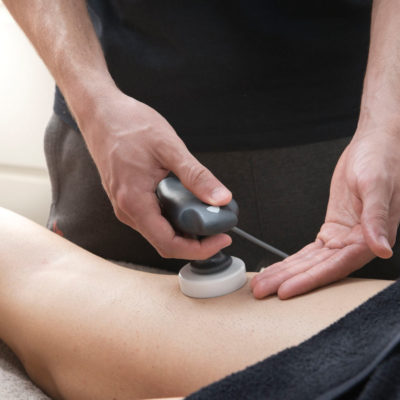Rehabilitation
Pain, inflammation, injuries, surgery recovery
are vast areas in which the variables to be taken into account to define optimal treatment are many. What do they have in common?
Most of the physiological processes necessary to have a good clinical result are related to the peripheral circulatory system and to neuromuscular communication.
The human body is a miraculously evolved system able to adapt to the most extreme conditions and to heal itself. Not only! It is also able to exploit well-directed external stimuli to its advantage.
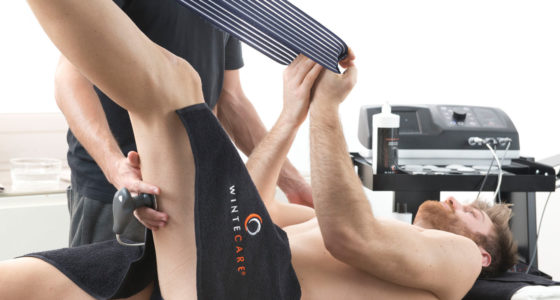
What is the role of a good therapist in this context?
- Making sure that the patient’s diagnosis and subjective understanding is well understood is certainly a good start.
- Acquire the anatomical, anatomopathological and physiological knowledge necessary to define the best treatment strategy.
- Acquire the most effective tools, first and foremost the perfect mastery of manual techniques, to induce the necessary reactions within the body to accelerate the solution of the problem
WINTECARE® is the ideal partner for those who want to have that something extra in the rehabilitation field.
We work side by side with clinics and physiotherapy centers in their development path. In addition to providing the best technologies, we help professionals who choose our devices to grow and achieve their goals.
By applying a method consolidated through experimentation and clinical applications entrusted to an international network of specialists, those who choose WINTECARE have access to rehabilitation application programs that include treatment of pain, tendinopathies, muscle disorders, chondropathies, cases of acute and chronic inflammation, pre and post surgical care, non-systemic and non-autoimmune peripheral phlebolymphatic pathologies. WINTECARE treatment programs are typically pleasant, non invasive and repeatable over time.
Clinical results always depend on the professionalism and competence of those applying the treatment and on how it is framed up in an application strategy consistent with the diagnosis. The enhancement of the therapist’s specific skills, associated with the use of WINTECARE tools, is one of the founding elements of the effectiveness of our programs.
Our systems in the rehabilitation field
Lower back pain, neck pain, tendinopathy, muscle injury, post surgery, chondropathy, sprain, lymphedema, bone fracture, functional limitation, contracture, hypotrophy, hypoxia, trigger point, myofascial painful syndrome, compartment syndrome, arthrosis, arthritis… are some of the possible areas of application of our systems in rehabilitation.
To identify the most suitable therapy for your case, it is always good to consult your referring physician, but for information purposes only, we will consider below some of the most common clinical cases …
Lower back pain
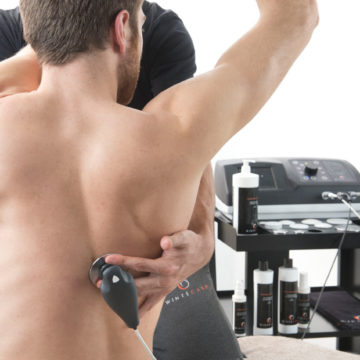

With lower back pain we mean a persistent pain in the lumbar area that can have multiple and often concomitant causes. In general it can be divided into three macro categories: non-specific, associated with radiculopathy (e.g. sciatica, cruralgia), associated with serious pathologies; luckily the latter are quite rare. The most common category is the non-specific lower back pain, the causes of which are often difficult to isolate: for example bad posture, an unfavorable environmental condition, a lifestyle that increases risk. Although linked to multiple causes, from a clinical point of view there are therapeutic schemes capable of acting on the structures most commonly involved in the generation of this pain such as: square of the loins, diaphragm, extensors of the column, buttocks, ileo-psoas, piriformis , facet joints, paravertebral muscles.
An experienced clinician is often able to make a diagnosis and apply an effective treatment strategy by selecting the most suitable modality for the specific case. The pharmacological approach tends to have an effect on symptoms but not necessarily on the causes of pain while physical therapy, based on treatments and exercise, is often effective by acting on the cause and increasing the probability of solving the problem in the medium-long run.
When symptoms are directly attributable to a compression of the vertebral discs that cause hernias with an impression on the dural sac or with compressions of the peripheral nerve roots, the solution is more complex. Although considerable space in scientific literature is dedicated to the issue of low back pain, there is not a protocol alone that can guarantee a solution to the problem as it is often linked to the concurrence of several factors. However, even in the case of pain generated by the compression of nerve roots or by hernias with an impression on the dural sac, there are cases in which it is possible to adopt conservative therapy that avoids surgery. This solution can be evaluated together with your specialist.
When the diagnosis is compatible with the application of a WINTECARE (R) treatment, the improvement of patient condition, both from the point of view of pain perceived and functional recovery, is evident from the first treatments.
Neck pain
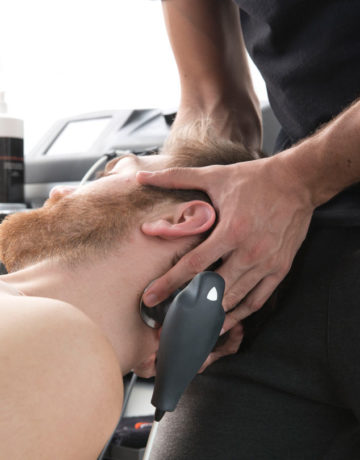
Cervicalgia means persistent pain localized in the cervical area of the spine and can have multiple causes, often concomitant. It can be associated with radiculopathies and nerve root compressions commonly generated by vertebral disc degeneration or biomechanical / postural imbalances. It is frequently associated with the term “non-specific” which indicates a difficult identification of a cause precisely related to the pain symptom.
A good diagnosis together with a correct analysis of the patient often allows to define effective conservative therapies. During the WINTECARE (R) treatments for neck pain, the most commonly treated structures are the facet joints, the paravertebral, trapezius, scalene, sternocleidomastoid muscles and all the skeletal muscle structures affected by the physiological movements of the head and neck. For example, if the painful area to be treated is not affected by an acute inflammatory process, induced increases in temperature at deep level help to reduce tissue tensions that trigger pain. When the pain originates mechanoceptively, i.e. from receptors sensitive to mechanical stimuli, the change in temperature acts on the plasticity and elasticity of the tissues themselves, significantly reducing the perception of pain. Ask for information >
Tendinopathy
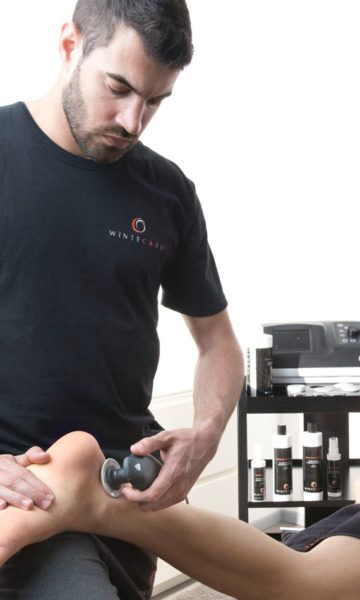
Tendinopathy identifies a pathological state of the tissues that make up a tendon. There are many and different levels of tendinopathies depending on the type of tissue, the origin and the location in the body however to simplify, we can say that the most common cause is attributable to chronic inflammation of the tissues that make up a tendon.
Inflammation is normally a physiological process of the body. It is a defensive response to an offensive event such as an injury or an overload. When the inflammation goes on for too long it transforms from a useful and physiological process to a chronic state damaging the affected parts of the body. To make a comparison with everyday life, we can associate acute inflammation with an efficient building site being completed smoothly in due time and according to the original project, while chronic inflammation can be compared with a messy construction site, interrupted even several times, scheduled in a disorganized manner and subject to continuous design variations.
In the case of a tendon affected by tendinopathy generated by chronic inflammation, the “building site” that should repair damaged tissues does not work properly and often generates more damage than repairs. This causes excessive fibrosis which could lead to phenomena such as calcifications. Following this analogy and supported by clinical studies that prove the effectiveness of the technologies used in WINTECARE programs to approach this problem, we can describe the intervention of the therapist in this area as a “healing” operation of the tissue. This occurs with targeted microcirculatory stimuli and applications that favor drainage and movement strategically combined. Ask for information >
Chondropathy
Chondropathy describes the pathological state of the cartilage tissues typically present in the joints.
There are various types and different stages of pathologies depending on the type of tissue, the intensity of the event and the location. In general, what is common to chondropathies is an often degenerative suffering of the cartilages that tend to thin, stiffen or take irregular shapes that impact negatively on pain and movement.
Condropathies can have multiple causes. When the main cause is attributable to the depletion of the nutritional supply to the affected area and to poor vascularization, targeted microcirculatory stimuli aimed at supporting blood perfusion of the vessels that irrigate the adjacent tissue can give good results in the long term, such as delaying the degeneration of the problem and sometimes supporting tissue regeneration. Ask for information >
Sprain
Distortion describes an anomalous movement of the joint that causes it to lose its congruity, though temporarily. Typically it generates swelling, pain, functional limitation and in some cases causes more or less repairable damage to the tissues that make up the joint. Typically tendons and ligaments are often affected by this event. A sprain generates short-term symptoms mainly attributable to pain and swelling with a marked limitation of joint mobility. In the long term, especially when not handled properly, it can cause permanent functional limitations.
The better you manage the acute phase of the sprain, the more likely you are to recover full joint functionality. Keeping edema under control by promoting drainage accelerates the reduction of pain and the progressive recovery of mobility. Ask for information >







